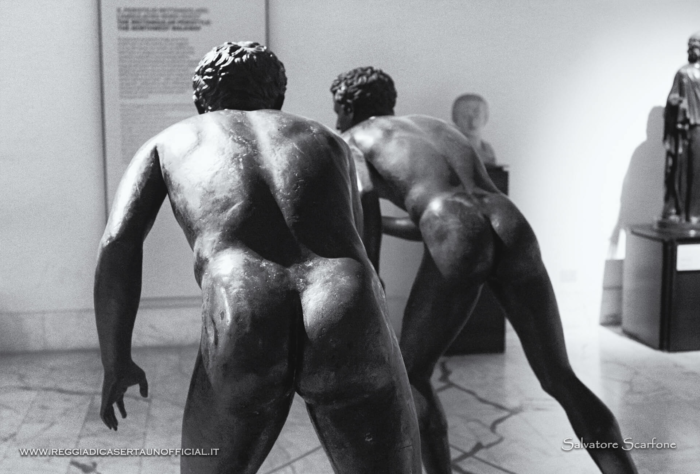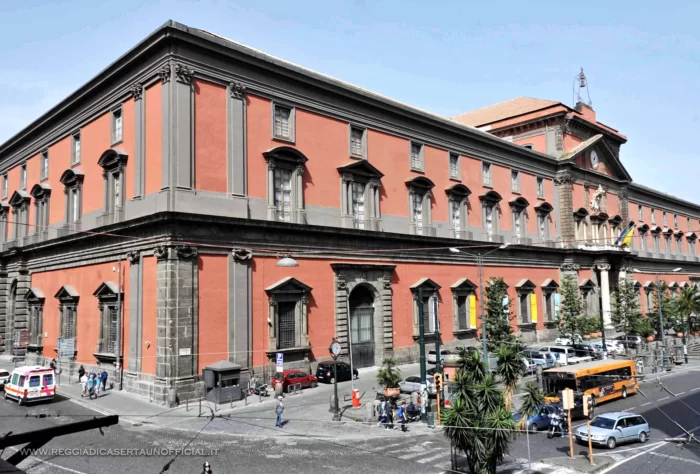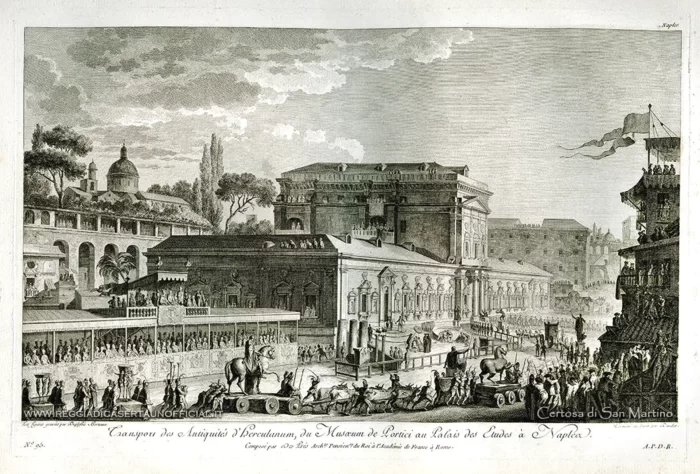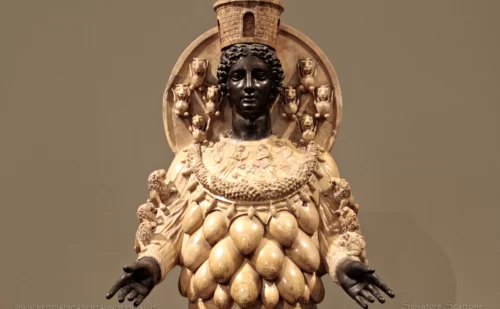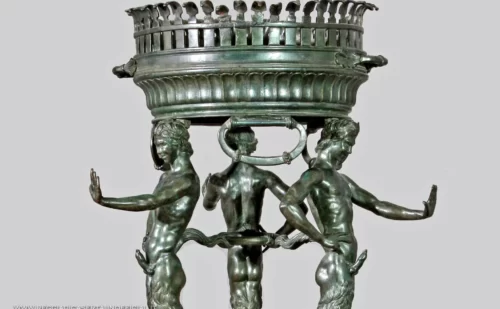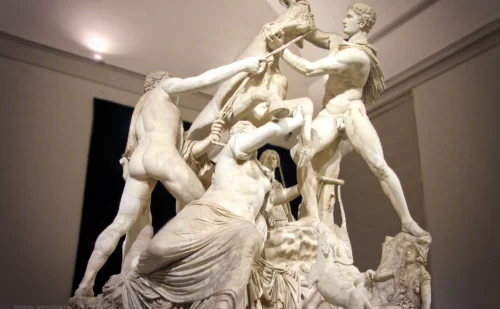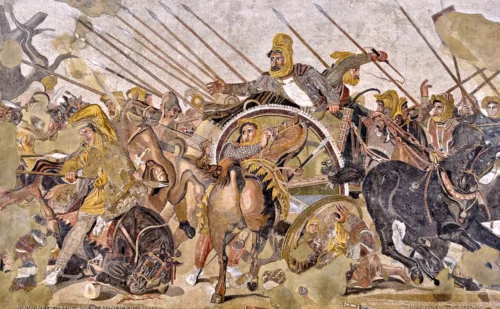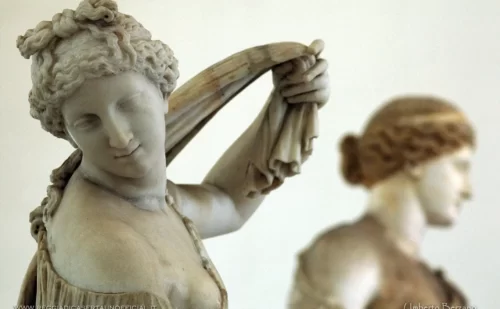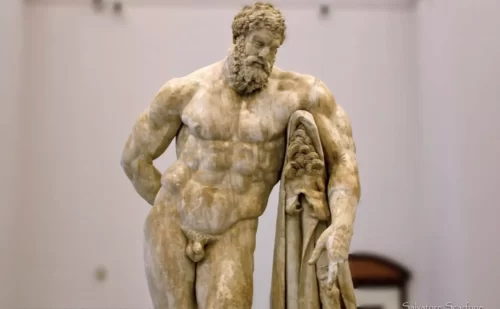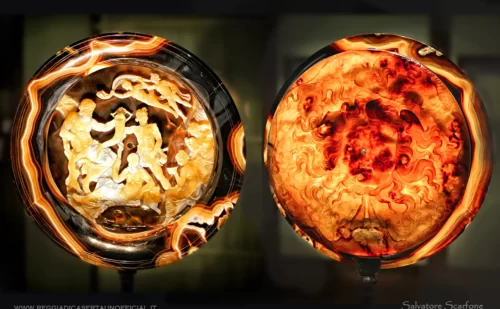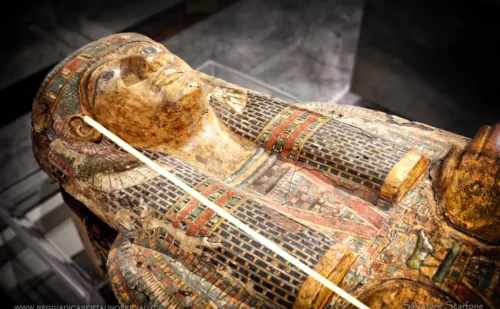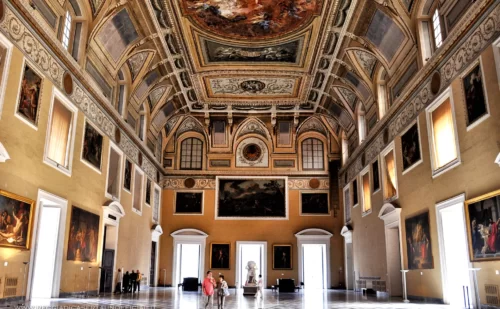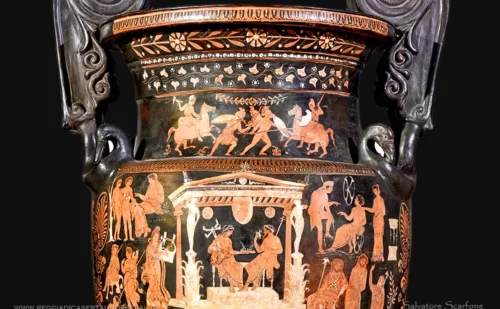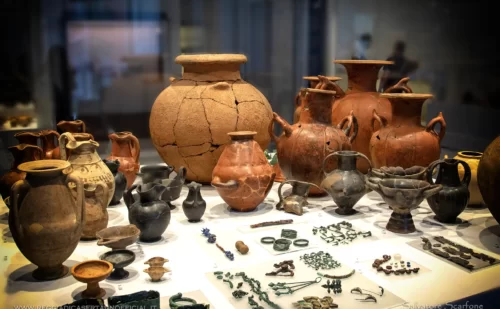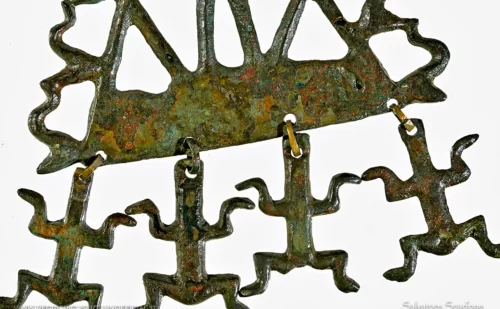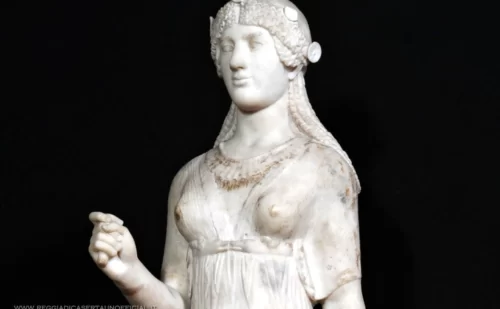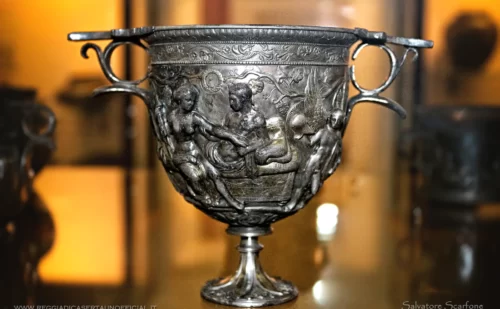The Archaeological Museum of Naples
The Archaeological Museum of Naples is the most important in the world. From prehistory, to Egypt and the Orient, the spectacular Farnese Collection, the finds from Pompeii and Herculaneum, etc., one is bound to be amazed.
History of the Museum
The construction works of the large building of the Archaeological Museum of Naples began in 1585, when the Spanish viceroy Pedro de Giron wanted to build a large barracks for the cavalry. In 1610 it was completed by the architect Giulio Cesare Fontana by order of the viceroy Pedro Fernandez de Castro, with the intention of hosting the university. With the transfer of the university, the renovation and expansion works of the building began, which was destined to become the Universal Museum.
In 1738, Herculaneum (Pompeii 10 years later), and King Charles of Bourbon, promoted exploration and excavations, therefore the archaeological heritage was constantly growing and the Villa Reale dei Portici, where initially statues, frescoes and everyday objects were placed that came from from the excavations of the Vesuvian cities, it turned out to be too small. In the 1780s it was decided to accept the idea of Luigi Vanvitelli and transfer the large archaeological collections in Naples, including the large Farnese collection which arrived in the Neapolitan city starting from 1787 by order of King Ferdinand IV. In 1791, it was planned to place an astronomical observatory in the large hall on the first floor of the building, still known today as the Salone della Meridiana.
During the decade of French domination (1806-1815) various installations were made, then in 1816 the Bourbons called it the Royal Bourbon Museum, conceiving it as the seat not only of the museum but of the Royal Library, the Academy of Drawing, and the Workshop of the Papyri . Over time it has also been enriched with collections donated by private individuals, and more and more thematic areas are opening up using the infinite collections present in the warehouses.
Timetables and tickets
The opening hours of the Archaeological Museum of Naples, the closing days and the purchase of tickets.
What to see in the Archaeological Museum of Naples
The Farnese Collection
The Farnese collection is the most famous Roman collection of antiquity. The initiator of the collection was Alessandro Farnese, future Pope Paul III in 1534. These finds on classical antiquity were acquired through the antiques market and archaeological excavations. The first documents that speak of the collection date back to the mid-sixteenth century in which, in addition to the description of the pieces, the place of discovery is reported, if this was known. The catalog includes large sculptures from the Baths of Caracalla, such as the Farnese Hercules and the Latin Hercules, now exhibited at the Royal Palace of Caserta. The collection includes a large number of other works that were donated to the Farnese family or confiscated by them from rival houses, such as one of the kneeling Barbers, for example. We also remember the precious Farnese cup which was owned by Lorenzo the Magnificent. The large quantity of materials from the Farnese collection, together with materials from the Vesuvian cities, makes the Archaeological Museum of Naples the largest museum in the world.
The Gem Collection
The Gemme collection has over two thousand specimens, most of which belong to the Farnese collection. This collection included gems from other notable private collections dating back to the 15th century. Currently the gems, ancient and modern, are exhibited in a selection of significant specimens: the collection of Ranuccio and Alessandro Farnese, the Barbo gems which include the Treasury of Lorenzo dei Medici; the gems of Fulvio Orsini. The Farnese cup is the most important object. Engraved in Alexandria of Egypt and datable between the end of the 2nd and 1st century BC. and is the most famous and largest cameo of antiquity, in sardonyx agate.
The Epigraphic Collection
The epigraphic collection presents a section of the main languages in use in central-southern Italy ranging from the 6th century BC. to the 2nd century AD Most of the epigraphs are in Latin, divided into inscriptions of a political-institutional nature, Pompeian inscriptions and inscriptions from Pozzuoli. There are two hundred texts in Greek from the main centers of Magna Graecia, such as Locri, Thuri and Ereclea and from the epigraphs of Naples, a city where the Greek language was the official language until the Roman imperial age. An important group of inscriptions bears witness to the numerous languages spoken in central-southern Italy before the advent of the Romans: there are epigraphs in Etruscan, Sabellic, Volscian and numerous testimonies of Oscan Pompeii.
The Egyptian Collection
Second in importance in Italy after the Egyptian Museum in Turin, it is distributed in seven rooms and organized into various thematic sections relating to characteristic aspects of Egyptian civilization: the sphere of power, the world of the dead, cults and magic, the social organization -economic. The finds are divided according to a collectible criterion: Borgia Collection, Picchianti Collection, Stevens Collection and the finds from excavations in Campania.
The Numismatic Collection
The coins on display cover a wide chronological range, from the first coins minted in Magna Graecia up to specimens from the Kingdom of the Two Sicilies. Most of the coins come from the Farnese, Borgia and Santangelo collections but also from excavations in the Vesuvian area and in southern Italy. The most famous coin is the golden medallion of Augustus of which it is the only example. The discovery took place in Pompeii in 1759.
The Meridian Hall
In 1791, it was planned to place an astronomical observatory in the large hall on the first floor of the building, still called the Salone della Meridiana today, which is one of the largest covered halls in Europe. The construction of the observatory did not take place, and only a sundial more than twenty-seven meters long was prepared. A graduated brass scale was placed on the polychrome marble floor on which, at midday, a ray of sunlight shines from a hole in the upper corner of the room. Painted medallions depicting the zodiac signs are set next to the graduated scale.
Magna Graecia
It exhibits finds of different origins and provenances found in the southern regions of the Kingdom of Naples where, from the end of the 7th century BC, the Greeks, coming into contact with the indigenous populations, gave rise to that historical and cultural phenomenon defined with the name of Magna Grecia . This collection develops along a chronological arc that goes from the end of the eighth century BC. to the 3rd century BC It is rich in thousands of vases and figurative terracottas. The Vase of Dario da Canosa or the funerary slabs of the Tomb of the Dancers from Ruvo, together with a large number of jewels of high quality and artistic value produced in Cuma and Taranto.
Ancient Campania
The Piana Campana collections exhibit the finds found in the Campania Region from the 18th century to the present day, and concern an era that goes from the Neolithic to the ancient world. They tell the stories of the innumerable peoples who have inhabited this extraordinary region, their myths, their life and the link with the afterlife.
Prehistory and Protohistory
The collections of prehistory and protohistory in the Archaeological Museum of Naples are developed on three levels: introductory (history of the collection and introduction to the subject); Prehistory (Paleolithic, with finds on hunting and fishing activities; Neolithic, when man became sedentary and the economy was born; Eneolithic with the story of the culture of death through the finds from the necropolis of Paestum etc); Protohistory (finds from the various phases of the Bronze and Iron Ages).
The finds of Pompeii and Herculaneum
The vast majority of everything that has been found in the archaeological areas of Pompeii and Herculaneum since the eighteenth century is contained in the Archaeological Museum of Naples.
In 1738 the discovery of the ancient city of Herculaneum took place, and King Charles of Bourbon decided to finance the excavations, ten years later the discovery of Pompeii also took place, and these finds caused a huge stir throughout Europe, attracting crowds of scholars and curious. Since 1757 the volumes of the “Antiquities of Herculaneum exhibited” were published and donated (a few years before the projects for the Royal Palace of Caserta) to all the European courts, where all the artistic objects and frescoes found in the excavations and which were part of the royal collections. These volumes, together with those of the projects of the Royal Palace of Caserta, not only gave enormous prestige to the Bourbons, and attracted fleets of aristocrats and scholars making Naples an international capital but, above all, gave rise to Neoclassicism. A curiosity: in the English Garden of the Royal Palace of Caserta, the architect Carlo Vanvitelli designed the Cryptoporticus, a reconstruction of a Pompeian gallery to give the visitor the suggestion of the first explorers of the excavations.
The mosaics
The mosaics, almost all emblèmata, come from private homes in Pompeii, Herculaneum and other sites in Campania. They cover a period of time that goes from the 2nd century BC. to the 1st century AD The collection houses some of the most famous and important mosaics in the world: Emblem "Ambulant Musicians" from the so-called villa of Cicero, are two emblems of Hellenistic tradition made with very small mosaic tiles. They are the oldest mosaics found in Pompeii, dated to the end of the 2nd century BC. Both mosaics bear the signature of the mosaicist Discurides of Samos. Emblem of Alexander is the most famous floor mosaic in the world and was found on 24 October 1831 in the house of the Faun, one of the oldest and most luxurious residences in Pompeii. It measures almost twenty square meters and the entire surface is made with the vermiculatum technique, that is by combining between 1.5 and 4 million tiny polychrome tiles. This mosaic was created by specialized Alexandrian workers working in Italy, who knew how to create a grandiose effect such as to reproduce a Greek pictorial original, which Pliny the Elder recalls as a work by Philoxenus of Eretria.
The Secret Cabinet
The Gabinetto Segreto collection is one of the most curious collections of the Archaeological Museum of Naples, which brings together 250 finds with an erotic subject from the excavations of Pompeii and Herculaneum. The collection illustrates aspects of sexuality in the ancient world. Often protagonists of erotic paintings were divinities and heroes or loves of feral beings such as Satyrs and finally the loves of Pan the protector of forests and flocks.
The frescoes
The collection of frescoes is truly unicum of Roman painting found in the Vesuvian area from private homes between the 1st century BC and the 1st century BC. and 1st century AD In this section you can see different pictorial styles, from the grandiose sets of the first century BC. to the decorative cycles of the Augustan age and the imperial age. In this collection there are themes of Roman painting, mostly inspired by mythology, the Homeric tale or Greek tragedy and portraits of private citizens.
The villa of the Papyri
The Villa dei Papiri in Herculaneum takes its name from the extraordinary discovery of over 1000 carbonised papyrus rolls which mostly yielded texts in Greek of Epicurean philosophy. It was a grand house owned by a member of the Roman nobility. It stood at the gates of Herculaneum on a terraced hill overlooking the sea, and is the most complete example of a villa for idleness and meditation. The main rooms of the villa were enriched with bronze and marble sculptures of whole figures or busts dating back to the Augustan age. Among the marvelous bronze statues, the following are to be admired: the pair of the two runners, Hermes Enagònios (Hermes at rest), the drunken satyr, the sleeping satyr and the half-bust of Scipio. The marble statues: Athena, Aeschines and the half-bust of Pyrrhus.
The Temple of Isis
The temple of Isis was discovered in 1764 and was the first cult building excavated in Pompeii. In the exhibition hall there is the reconstructive model to remind visitors of how the structure was brought to light. Furthermore, you can admire the portico of the monument with its wall decorations which constitutes the fulcrum of the collection.
Objects of daily life
With the excavation campaign in the sites of Herculaneum and Pompeii, in addition to the temples, public buildings, mosaics and frescoes, a very large quantity of utensils, pottery, objects of daily life were brought to light which constitute the most significant testimony of the uses and customs, cultural and religious traditions of the inhabitants of Pompeii and Herculaneum.
Prepare your visit to the Museum
Find out the opening hours of the Archaeological Museum of Naples, the closing days, buy tickets etc
Guided tours and tickets
Discover the types of guided tours and tickets available for the Naples Archaeological Museum
Documentary on the Archaeological Museum of Naples
Watch the documentary on the Archaeological Museum of Naples conducted by Alberto Angela for Super Quark
